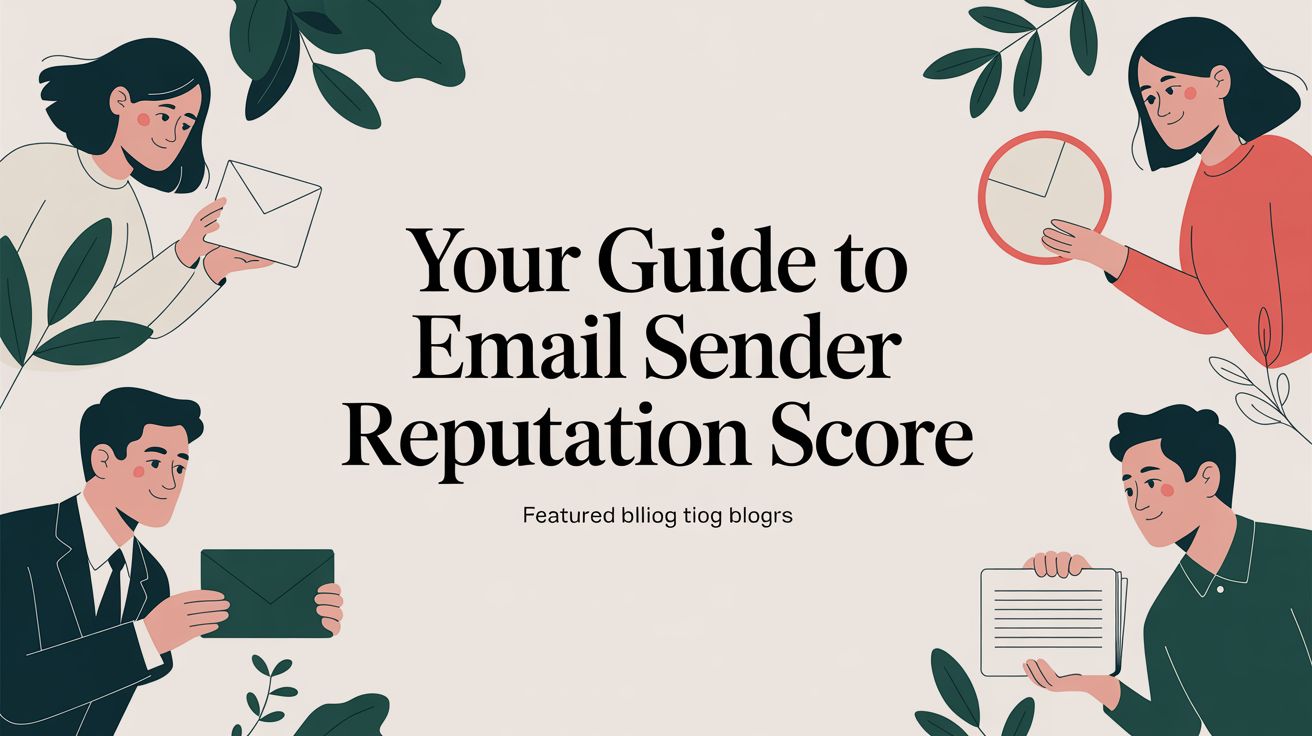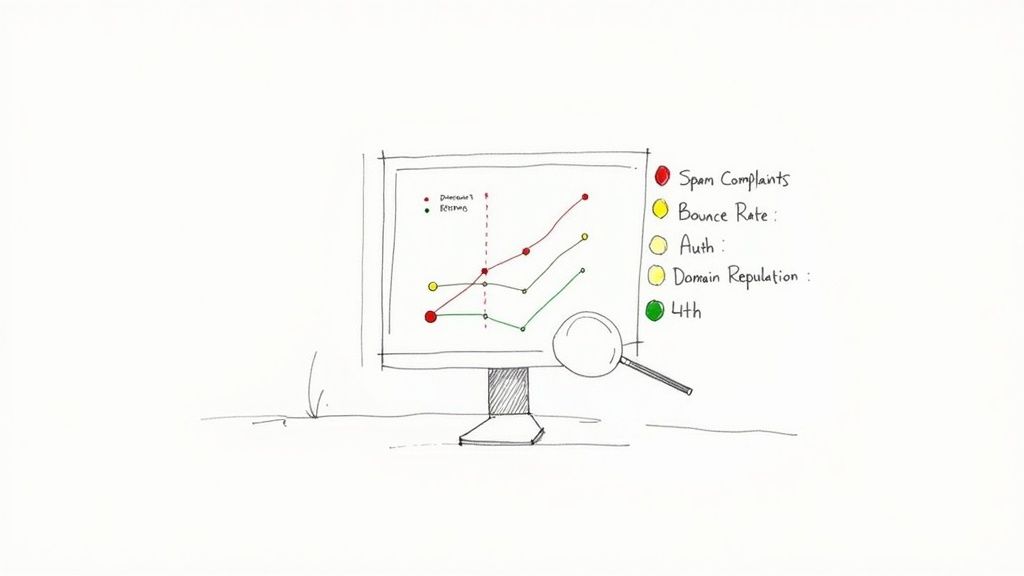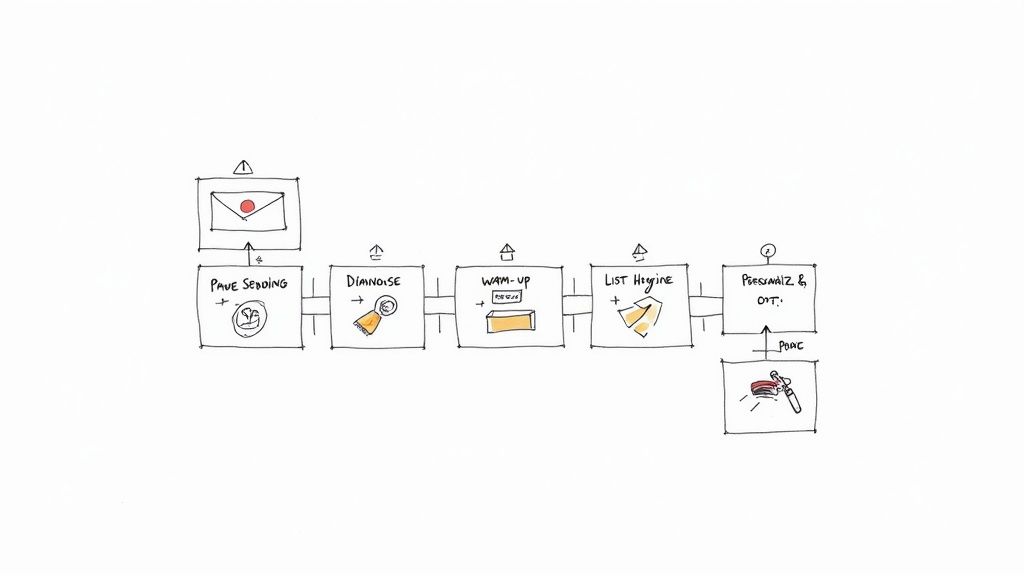How to Avoid Spam Filters Your Cold Outreach Guide
Learn how to avoid spam filters with this practical guide. Get expert tips on technical setup, email content, and list hygiene for cold outreach.
Read article
Your email sender reputation score is a number between 0 and 100 that email providers use to decide if you’re a trustworthy sender. Think of it like a credit score for your email domain. A great score gets your emails delivered straight to the primary inbox, while a poor one gets you a one-way ticket to the spam folder.
If you're running cold outreach campaigns, this score is pretty much the most important metric you need to watch.
Let’s use an analogy. Imagine you’re a bouncer at an exclusive nightclub—the “primary inbox.” Every person trying to get in (an email) has a reputation. Some are well-known regulars who are always welcome. Others have a history of causing problems. Your job as the bouncer is to let the good ones in and keep the troublemakers out.
Mailbox providers like Google and Microsoft are that bouncer, and your sender reputation is their main way of judging whether to let you in.
This score isn't just for show; it has a direct, real-world impact on your email deliverability. A high score is a green light to providers, telling them that people actually want to see your emails. A low score, on the other hand, is a major red flag that gets your messages filtered, blocked, or buried in the spam folder.
When it comes to cold email, your reputation is your lifeline. Unlike marketing emails where people have already opted in, you’re starting from a place of zero trust. Because of this, Internet Service Providers (ISPs) watch cold outreach like a hawk.
A huge part of the game is simply staying out of the junk folder. If you're looking for actionable tips, this guide on how to prevent emails from going to spam is a great resource. A solid sender score is your best defense.
Your reputation is built over time, based on a history of positive interactions. Every open, every reply, and every click builds trust. On the flip side, every spam complaint and hard bounce chips away at it.
To give you a better idea of what these scores mean in practice, here’s a quick breakdown.
This table provides a quick reference for understanding what different score ranges mean for your email deliverability.
| Score Range | Reputation Level | Expected Deliverability Outcome |
|---|---|---|
| 80-100 | Excellent | Emails consistently land in the primary inbox. |
| 70-79 | Good | Most emails land in the inbox, but some may be filtered to secondary tabs. |
| 50-69 | Poor | A significant portion of emails will go to spam or be blocked entirely. |
| 0-49 | Very Poor | The vast majority of emails will be blocked or sent directly to spam. |
Essentially, you want to keep your score above 80 to ensure your emails are actually being seen. Once you dip below 70, you're in the danger zone, where providers start actively filtering your messages. If you’re serious about growing your business with outreach, keeping a close eye on your sender reputation isn't just a good idea—it's essential. You can read more about how this score impacts your sending practices on Twilio's blog.
Think of mailbox providers like Google and Microsoft as gatekeepers. Their main job is to protect their users from the endless flood of spam. To do this, they act like detectives, piecing together clues to figure out if you're a legitimate sender or just another spammer trying to sneak through.
Your email sender reputation score isn't just one number; it’s a complex profile built from dozens of signals about your sending habits. Getting a handle on these signals is the first real step toward mastering your deliverability and making sure your emails actually get seen.
Every single email you send is tied to two things: an IP address and your sending domain. For anyone doing cold outreach, domain reputation is king. Why? Because it’s your brand’s permanent record. It follows you everywhere, even if you switch sending platforms and your IP address changes. It's a long-term asset you have to protect.
I once saw a post on Reddit where a sales agency thought they could just ditch their blacklisted domain and start fresh with a new one. Big mistake. Their emails went straight to spam because a brand-new, unknown domain is a huge red flag for providers. You have to earn their trust over time.
At the end of the day, providers care most about what their users think of your emails. Positive engagement is the most powerful proof you can offer that your emails are wanted. When people open, click, and—most importantly—reply to your messages, it screams "this isn't spam!" to the algorithms.
On the flip side, negative engagement can tank your reputation fast. Here’s what hurts you the most:
This whole process is a balancing act, and every action your recipients take pushes your reputation one way or the other.

As you can see, it's a pretty clear cause-and-effect relationship. Good signals build a high reputation, which leads to the inbox. Bad signals drag it down, sending you to the spam folder with the mailbox providers acting as judge and jury.
Years ago, setting up your email authentication was a "nice-to-have." Today, it's the absolute bare minimum. Think of SPF, DKIM, and DMARC as your email’s official ID. They prove to the world that you are who you say you are and that no one has messed with your email on its way to the inbox.
Without proper authentication, mailbox providers have no way to verify you're legit, and many won't even bother trying—they'll just block you. It’s no longer a suggestion; it's a non-negotiable for anyone serious about outreach.
Remember, providers are in a constant battle against phishing and spoofing scams. When you authenticate your domain, you're making their job easier and showing you're on their side. That’s a huge trust-builder. If you're not sure about your current setup, using a deliverability score tool can quickly show you any technical gaps you need to fix.
Alright, let's move from the "what" to the "how." Checking your email sender reputation score isn't just a good idea; it's a vital part of keeping your outreach engine running smoothly. Think of it like a regular health checkup—you need to know your numbers to catch problems before they become serious.
The key is to look for trends, not just a single snapshot in time. A one-off score is interesting, but seeing how that score changes week-to-week tells the real story. A sudden dip is your early warning system, screaming that something in your recent campaigns needs a closer look.
So, where do you get these numbers? A few trusted, free tools are the gold standard in the industry. Each gives you a slightly different angle on your reputation, and using them together provides a complete picture of how mailbox providers see you.
Behind the scenes, mailbox providers are crunching enormous amounts of data. Services like Cisco Talos are constantly analyzing global email traffic, looking at things like bounce rates and spam complaints to feed their algorithms. As a rule of thumb, keeping your bounce rate below 2% and your spam complaint rate under 0.02% is crucial for maintaining a healthy reputation.
Getting the data is just step one. The real skill is in the diagnosis.
Let's say you log into Google Postmaster and see your domain reputation just dropped from "High" to "Medium." What do you do? Don't panic. Go straight to the data from your last few campaigns. Are your bounce rates creeping up? Did one specific campaign get a spike in spam complaints? This is how you connect a drop in your score to a specific action you took.
For a simpler way to keep tabs on your sending health, you might find our guide on how to perform a reputation check useful.
Here’s a peek at what the SenderScore dashboard looks like in action:

That score of 98 is exactly what you want to see—it’s the gold standard. It tells mailbox providers that this IP is a trustworthy sender. The big lesson here is the clear link between a high score and the ability to send high volume with almost zero complaints. That's the sweet spot every sales and marketing team should be aiming for.

If your open rates are in a nosedive and replies have all but vanished, your email sender reputation score has probably taken a serious hit. The good news? This is completely fixable. But it’s going to take a disciplined, strategic plan to get back on track.
The first step is always the hardest: you have to stop all large-scale sending immediately.
Trying to power through a damaged reputation by sending more emails is like trying to outrun a flat tire—it only makes the damage worse and digs you into a deeper hole. Instead, take a breath and use the diagnostic tools we talked about to figure out exactly what went wrong. Was it a high bounce rate from a bad list? A sudden spike in spam complaints? You can't fix a problem you haven't identified.
Once you’ve stopped all campaigns, your only job is to become a detective. I once saw a Reddit user in r/sales explain how their agency's deliverability completely cratered. Their first instinct was to keep emailing their "best" contacts, but the damage was already done. The real fix came when they paused everything for two weeks, dug into their Google Postmaster data, and found that a single bad list had poisoned their entire domain.
Here's your diagnostic checklist:
Okay, you've stopped the bleeding. Now it's time to start rebuilding trust with the big email providers like Google and Microsoft. This is where a methodical warm-up process is absolutely critical. You can't just flip a switch and go back to sending hundreds of emails a day. You have to earn your way back into the inbox.
Start small. Send no more than 10-20 emails per day, and send them only to your most engaged contacts. I'm talking about people who have replied to you before or prospects you have a genuine connection with. The goal here is to generate positive signals—opens, clicks, and especially replies—to prove to the inbox providers that your emails are actually wanted.
The warm-up process is a marathon, not a sprint. It’s a slow, deliberate effort to prove you’re a legitimate sender. Rushing this step will land you right back where you started.
From there, you can slowly increase your sending volume by about 10-20% each day. But—and this is a big "but"—only do this if you're maintaining high engagement and near-zero bounce rates. This gradual ramp-up rebuilds your reputation on a solid foundation, not on shaky ground.
While you're warming up your domains, ruthless list hygiene becomes non-negotiable. You simply cannot afford to send to a single invalid email address. Not one.
For a deeper dive into building a sustainable sending strategy, check out these essential email deliverability best practices.
By combining a disciplined pause with a methodical warm-up and impeccable list hygiene, you can systematically repair a damaged email sender reputation and rebuild the trust you need for successful outreach.
https://www.youtube.com/embed/H-i_FIT-2HM
Theory is one thing, but seeing how email sender reputation plays out in the real world is where the best lessons are learned. The internet is full of cautionary tales and hard-won successes, especially in communities on places like Reddit. These stories show just how fast a reputation can be built—or completely torched.
Think of these less as anecdotes and more as practical case studies in what works and what to avoid at all costs.
One of the most common horror stories you'll hear involves an agency getting a little too eager. In one discussion, a user shared how their marketing team bought a massive, unvetted list of 50,000 contacts for a new client. Desperate to show quick results, they blasted the entire list without a second thought for warm-ups or list cleaning.
The result was an absolute catastrophe. Their bounce rate skyrocketed past 30%, and spam complaints came pouring in. In less than 48 hours, their domain was permanently blacklisted by major email providers. They didn't just hurt their reputation; they destroyed a valuable company asset and had to start from scratch with a new domain. It was a painful lesson in patience.
This kind of story is a powerful reminder: in cold outreach, quality and preparation always win over sheer speed and volume. One bad move can wipe out years of careful reputation building.
Now for the flip side. A small B2B startup with a tight budget knew they couldn't afford a single misstep that would get their domain flagged. So, they took the complete opposite approach: slow and steady. They started with a meticulous warm-up, sending just 10-15 hyper-personalized emails a day from a list they had researched obsessively.
Every email mentioned a specific trigger—a recent company announcement, a shared connection, a post on LinkedIn. This highly relevant approach earned them an incredible reply rate of over 25%. All that positive engagement sent a clear signal to mailbox providers that their emails were wanted. Over a few months, they built an iron-clad sender reputation that let them scale their outreach confidently, knowing they'd land in the inbox.
Sender reputation is directly tied to engagement and deliverability, yet a shocking number of people are flying blind. A recent survey revealed that only about 25.5% of email marketers felt they truly understood sender reputation, which points to a major knowledge gap in the industry. You can discover more insights about sender reputation awareness on Mailjet.
Finally, consider the company that watched its deliverability suddenly fall off a cliff. Their open rates nosedived from a healthy 40% to under 10% in a single week. After frantically digging into their analytics, they found the smoking gun: their hard bounce rate had crept up to 5%, far beyond the 2% industry danger zone.
What happened? They had recycled an old, decayed contact list for a new campaign. To stop the bleeding, they immediately paused all sending and ran the entire list through an email verification tool. After purging thousands of bad addresses, they slowly started sending again to the clean list. It took nearly a month of consistent, low-bounce campaigns to repair their email sender reputation score, but they eventually clawed their way back.
Trying to figure out your email sender reputation score can feel like wading through a sea of conflicting advice. Let's cut through the noise and tackle the questions I hear most often from sales teams and agencies, with straight answers grounded in how cold outreach actually works.
This is the million-dollar question, and the answer is always a marathon, not a sprint. Fixing a trashed reputation isn’t like flipping a switch. It’s about methodically proving to mailbox providers that you’ve changed your sending habits for good.
From what I’ve seen and from countless recovery stories shared on forums like Reddit, you should plan for this to take anywhere from three weeks to two months. That means a slow, deliberate warm-up, ruthless list cleaning, and an obsessive focus on getting positive replies—not just opens. Trying to rush it will only dig you a deeper hole.
Not a chance. In fact, providers like Google and Microsoft see a brand-new domain as intensely suspicious. It’s like a stranger walking into a tight-knit community; they have zero trust built up.
A fresh domain has no sending history, which is a massive red flag. One user in r/sales shared how they tried this "reset" only to have their emails land straight in spam for weeks. You have to treat a new domain with even more caution than an established one, warming it up slowly and meticulously to build its reputation from scratch.
They both matter, but for cold outreach, your domain reputation is your brand's permanent identity. You might change sending platforms and get a new IP address, but that domain name follows you everywhere. Mailbox providers are increasingly tying sender trust directly to the domain.
Think of it this way: your IP is the car you’re driving, but your domain is your driver's license. You can switch cars, but your driving record—your domain reputation—sticks with you. Protect your domain above all else; it's by far the more valuable asset for the long haul.
This is one of those tempting shortcuts that almost always ends in disaster. Buying an "aged" domain with a supposedly clean reputation is a massive gamble because you can never truly know its full history.
Was it used for spam five years ago? Is it on some obscure, private blacklist you can't see? A Redditor once told a story about buying a "clean" aged domain only to discover it was on a private blacklist, rendering it completely useless for outreach.
The only reliable path is to build and protect your own asset. Earning a good email sender reputation score yourself is the only way to guarantee deliverability and success for your campaigns long-term.
Ready to build and protect your sender reputation without the guesswork? InboxKit provides the turnkey cold email infrastructure you need. We automate technical setup, provide pristine mailboxes, and give you the tools to scale your outreach while maintaining the highest inbox placement. Get started with InboxKit today.
Learn how to avoid spam filters with this practical guide. Get expert tips on technical setup, email content, and list hygiene for cold outreach.
Read articleExplore b2b email marketing best practices with practical tips to boost open rates, engagement, and conversions in 2025.
Read articleDiscover how to manage multiple email accounts efficiently with simple steps, workflows, and tools to stay organized and save time.
Read articleInboxKit provides everything you need to reach the inbox consistently